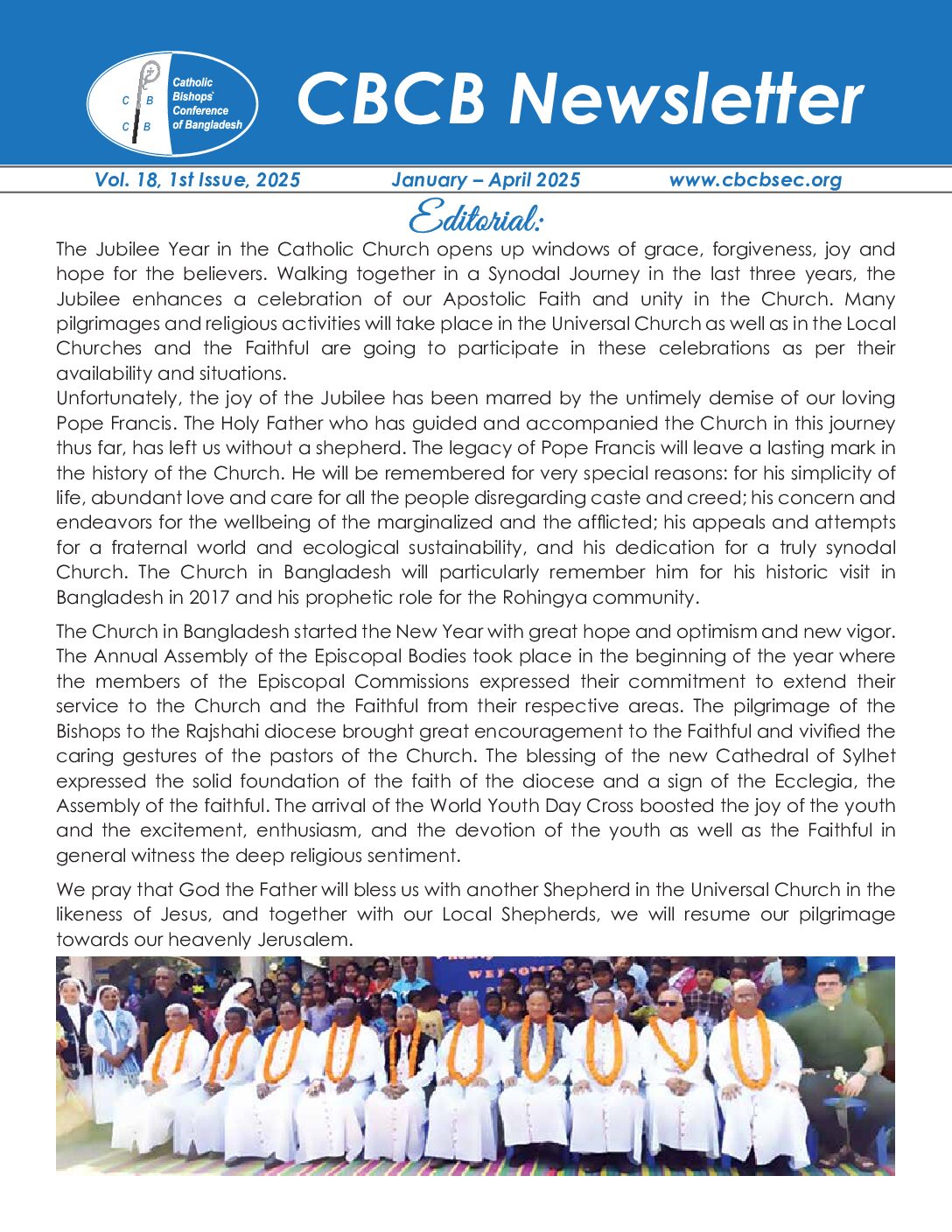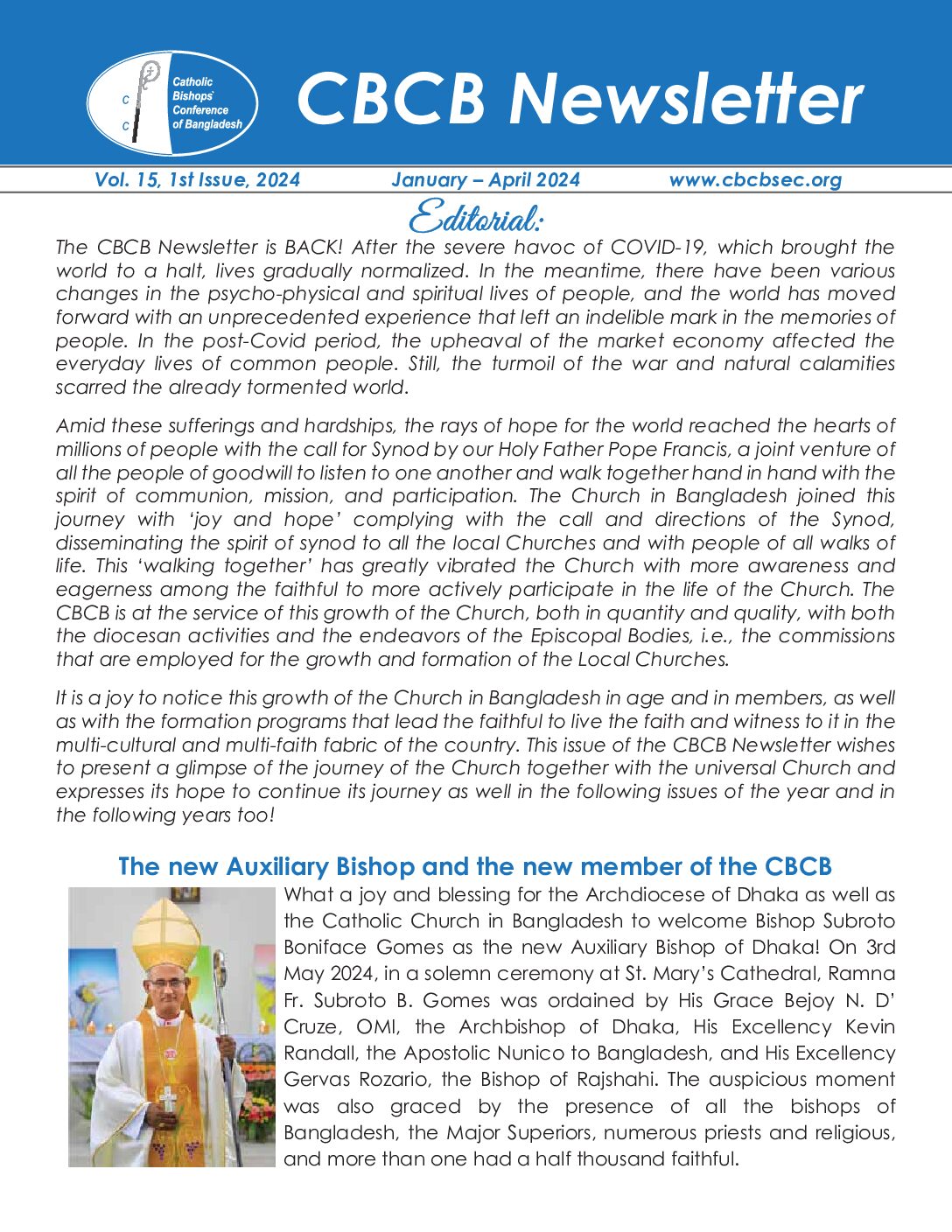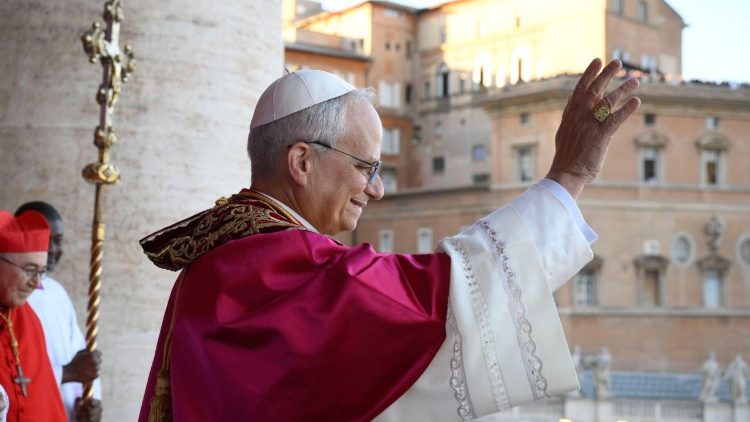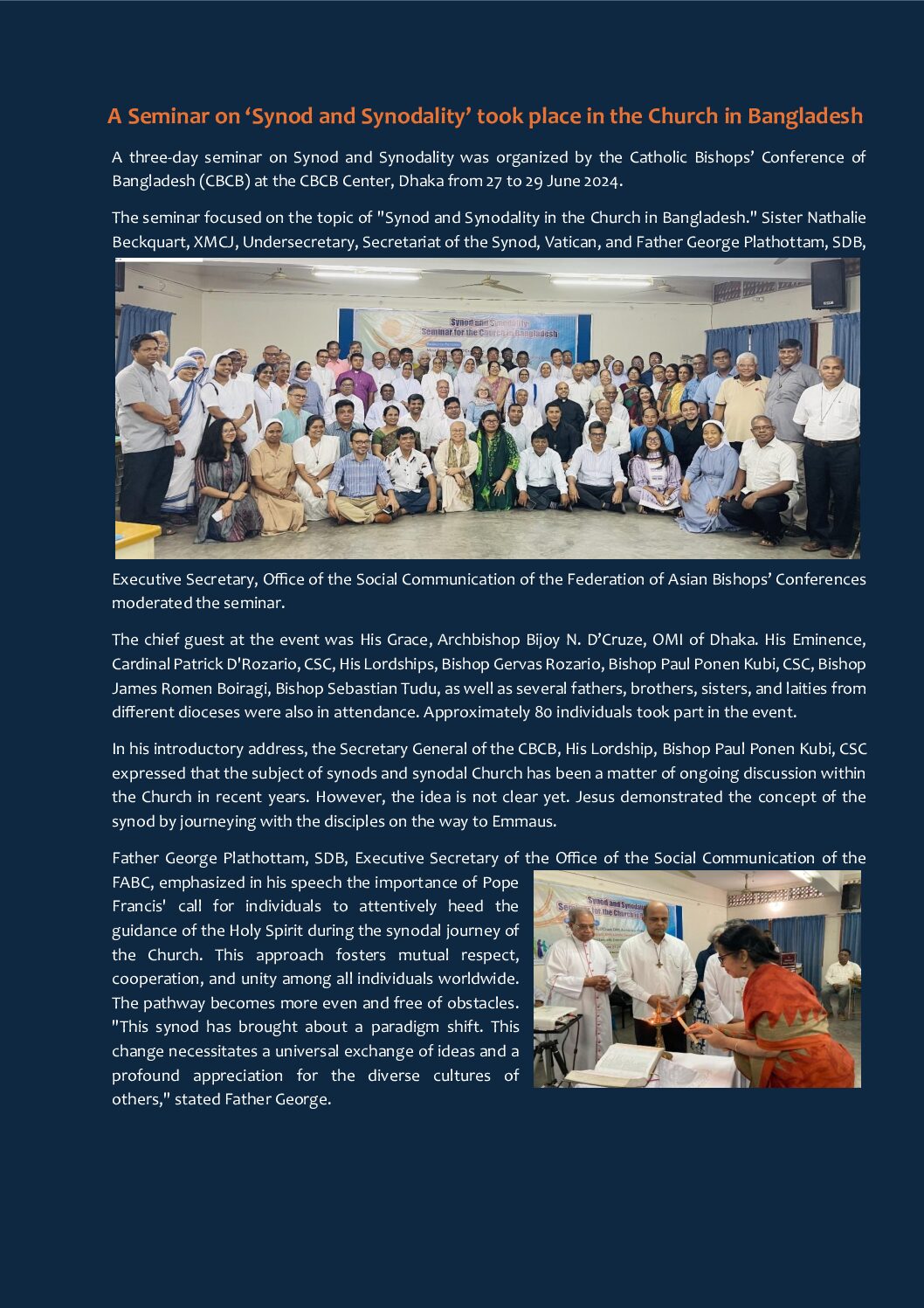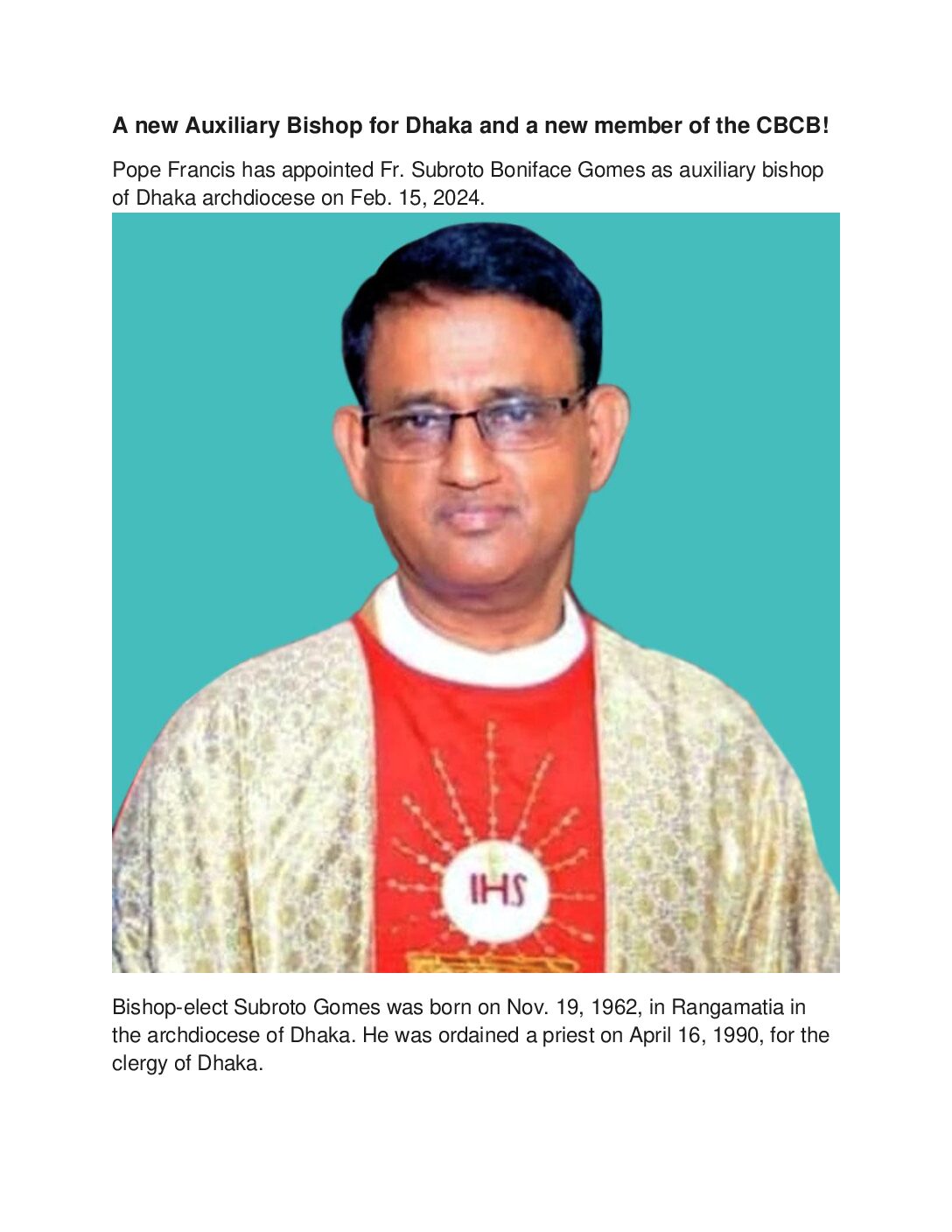Newly Ordained Deacons
Congratulations to the Newly Ordained Deacons!
On May 24, 2025 a total of fifteen diocesan deacons were ordained in a solemn Eucharist at the Holy Spirit Major Seminary, Dhaka. The celebration was presided over by Bishop Gervas Rozario of Rajshahi. Among these fifteen deacons, Six are from Rajshahi, three from the Archdiocese of Dhaka, two each from Barishal and Dinajpur, and one each from the Archdiocese of Chattogram and the Diocese of Khulna.
The ordination drew a large gathering of nearly 1,000 faithful, including bishops, priests, religious sisters, and the families and friends of the ordinands. Among the prominent attendees were Archbishop Lawrence S. Howlader of Chattogram, Bishop Rozario of Rajshahi, Bishop Sebastian Tudu of Dinajpur, and Bishop Emmanuel Rozario of Barishal—all offering their prayerful presence and support.
In his homily, Rozario reminded the new deacons of their sacred duty:
“You are called to serve—not to be served. Your ministry begins at the altar but extends into the daily lives of the people you are entrusted to guide. Always proclaim the Good News and remain prayerful—for yourselves and for the faithful—so that you may remain close to God.”
Father Paul Gomes, Rector of the Seminary, acknowledged the deep commitment and long journey of each ordinand:
Their vocations have been nurtured through prayer, guidance, and the support of many”. We give thanks to God for each of them, and we pray that their service to the Church as deacons may be marked by humility, joy, and dedication.”
The ceremony concluded with a lively cultural program and a reception in honor of the new deacons. Father Paul Gomes formally closed the event by offering heartfelt thanks to all who contributed to the celebration, especially the families and communities that supported the ordinands throughout their journey.
(Source of information: Radio Veritas Asia)
New Pope Leo XIV
Biography of Pope Leo XIV, born Robert Francis Prevost
By Vatican News
The first Augustinian Pope, Leo XIV is the second Roman Pontiff – after Pope Francis – from the Americas. Unlike Jorge Mario Bergoglio, however, the 69-year-old Robert Francis Prevost is from the northern part of the continent, though he spent many years as a missionary in Peru before being elected head of the Augustinians for two consecutive terms.
First Augustinian Pope
The new Bishop of Rome was born on September 14, 1955, in Chicago, Illinois, to Louis Marius Prevost, of French and Italian descent, and Mildred Martínez, of Spanish descent. He has two brothers, Louis Martín and John Joseph.
He spent his childhood and adolescence with his family and studied first at the Minor Seminary of the Augustinian Fathers and then at Villanova University in Pennsylvania, where in 1977 he earned a Degree in Mathematics and also studied Philosophy.
On September 1 of the same year, Prevost entered the novitiate of the Order of Saint Augustine (O.S.A.) in Saint Louis, in the Province of Our Lady of Good Counsel of Chicago, and made his first profession on September 2, 1978. On August 29, 1981, he made his solemn vows.
The future Pontiff received his theological education at the Catholic Theological Union in Chicago. At the age of 27, he was sent by his superiors to Rome to study Canon Law at the Pontifical University of Saint Thomas Aquinas (Angelicum).
In Rome, he was ordained a priest on June 19, 1982, at the Augustinian College of Saint Monica by Archbishop Jean Jadot, then pro-president of the Secretariat for Non-Christians, which later became the Pontifical Council for Interreligious Dialogue and then the Dicastery for Interreligious Dialogue.
Prevost obtained his licentiate in 1984 and the following year, while preparing his doctoral thesis, was sent to the Augustinian mission in Chulucanas, Piura, Peru (1985–1986). In 1987, he defended his doctoral thesis on “The Role of the Local Prior in the Order of Saint Augustine” and was appointed vocation director and missions director of the Augustinian Province of “Mother of Good Counsel” in Olympia Fields, Illinois (USA).
Mission in Peru
The following year, he joined the mission in Trujillo, also in Peru, as director of the joint formation project for Augustinian candidates from the vicariates of Chulucanas, Iquitos, and Apurímac.
Over the course of eleven years, he served as prior of the community (1988–1992), formation director (1988–1998), and instructor for professed members (1992–1998), and in the Archdiocese of Trujillo as judicial vicar (1989–1998) and professor of Canon Law, Patristics, and Moral Theology at the Major Seminary “San Carlos y San Marcelo.” At the same time, he was also entrusted with the pastoral care of Our Lady Mother of the Church, later established as the parish of Saint Rita (1988–1999), in a poor suburb of the city, and was parish administrator of Our Lady of Monserrat from 1992 to 1999.
In 1999, he was elected Provincial Prior of the Augustinian Province of “Mother of Good Counsel” in Chicago, and two and a half years later, the ordinary General Chapter of the Order of Saint Augustine, elected him as Prior General, confirming him in 2007 for a second term.
In October 2013, he returned to his Augustinian Province in Chicago, serving as director of formation at the Saint Augustine Convent, first councilor, and provincial vicar—roles he held until Pope Francis appointed him on November 3, 2014, as Apostolic Administrator of the Peruvian Diocese of Chiclayo, elevating him to the episcopal dignity as Titular Bishop of Sufar.
He entered the Diocese on November 7, in the presence of Apostolic Nuncio James Patrick Green, who ordained him Bishop just over a month later, on December 12, the Feast of Our Lady of Guadalupe, in the Cathedral of Saint Mary.
His episcopal motto is “In Illo uno unum”—words pronounced by Saint Augustine in a sermon on Psalm 127 to explain that “although we Christians are many, in the one Christ we are one.”
Bishop of Chiclayo, Peru, from 2015 to 2023
On September 26, 2015, he was appointed Bishop of Chiclayo by Pope Francis. In March 2018, he was elected second vice-president of the Peruvian Episcopal Conference, where he also served as a member of the Economic Council and president of the Commission for Culture and Education.
In 2019, Pope Francis appointed him a member of the Congregation for the Clergy (July 13, 2019), and in 2020, a member of the Congregation for Bishops (November 21). Meanwhile, on April 15, 2020, he was also appointed Apostolic Administrator of the Peruvian Diocese of Callao.
Prefect of the Dicastery for Bishops
On January 30, 2023, the Pope called him to Rome as Prefect of the Dicastery for Bishops and President of the Pontifical Commission for Latin America, promoting him to the rank of Archbishop.
Created Cardinal in 2023
Pope Francis created him Cardinal in the Consistory of September 30, 2023, and assigned him the Diaconate of Saint Monica. He officially took possession of his titular church on January 28, 2024.
As head of the Dicastery, he participated in the Pope’s most recent Apostolic Journeys and in both the first and second sessions of the 16th Ordinary General Assembly of the Synod of Bishops on synodality, held in Rome from October 4 to 29, 2023, and from October 2 to 27, 2024, respectively.
Meanwhile, on October 4, 2023, Pope Francis appointed him as a member of the Dicasteries for Evangelization (Section for First Evangelization and New Particular Churches), for the Doctrine of the Faith, for the Eastern Churches, for the Clergy, for Institutes of Consecrated Life and Societies of Apostolic Life, for Culture and Education, for Legislative Texts, and of the Pontifical Commission for the Vatican City State.
Finally, on February 6 of this year, the Argentine Pope promoted him to the Order of Bishops, granting him the title of the Suburbicarian Church of Albano.
Three days later, on February 9, he celebrated the Mass presided over by Pope Francis in St. Peter’s Square for the Jubilee of the Armed Forces, the second major event of the Holy Year of Hope.
During the most recent hospitalization of his predecessor at the “Gemelli” hospital, Prevost presided over the Rosary for Pope Francis’s health in Saint Peter’s Square on March 3.
Source
Vatican News
A Seminar on ‘Synod and Synodality’ took place in the Church in Bangladesh
A Seminar on ‘Synod and Synodality’ took place in the Church in Bangladesh
A three-day seminar on Synod and Synodality was organized by the Catholic Bishops’ Conference of Bangladesh (CBCB) at the CBCB Center, Dhaka from 27 to 29 June 2024.
The seminar focused on the topic of “Synod and Synodality in the Church in Bangladesh.” Sister Nathalie Beckquart, XMCJ, Undersecretary, Secretariat of the Synod, Vatican, and Father George Plathottam, SDB, Executive Secretary, Office of the Social Communication of the Federation of Asian Bishops’ Conferences moderated the seminar.
The chief guest at the event was His Grace, Archbishop Bijoy N. D’Cruze, OMI of Dhaka. His Eminence, Cardinal Patrick D’Rozario, CSC, His Lordships, Bishop Gervas Rozario, Bishop Paul Ponen Kubi, CSC, Bishop James Romen Boiragi, Bishop Sebastian Tudu, as well as several fathers, brothers, sisters, and laities from different dioceses were also in attendance. Approximately 80 individuals took part in the event.
In his introductory address, the Secretary General of the CBCB, His Lordship, Bishop Paul Ponen Kubi, CSC expressed that the subject of synods and synodal Church has been a matter of ongoing discussion within the Church in recent years. However, the idea is not clear yet. Jesus demonstrated the concept of the synod by journeying with the disciples on the way to Emmaus.
Father George Plathottam, SDB, Executive Secretary of the Office of the Social Communication of the FABC, emphasized in his speech the importance of Pope Francis’ call for individuals to attentively heed the guidance of the Holy Spirit during the synodal journey of the Church. This approach fosters mutual respect, cooperation, and unity among all individuals worldwide. The pathway becomes more even and free of obstacles. “This synod has brought about a paradigm shift. This change necessitates a universal exchange of ideas and a profound appreciation for the diverse cultures of others,” stated Father George.
The seminar commenced by the Solemn Eucharist sacrificed by His Eminence, Cardinal Patrick D’Rozario, CSC. In his homily, Cardinal D’Rozario said, “Pope Francis urged the Synodal Church to adopt a fresh perspective, likening it to the role of a Prophet. We attentively listen to others. Over time, several secular views and ideals have infiltrated the Church, causing us to become more insular and less receptive to the perspectives of others. The Pope urges us to collectively engage in this synodal process in order to liberate ourselves from that state of exile.”
The primary objective of this conference was to familiarize individuals at all levels of the Church with the concept of “Synod and Synodality”. The topics discussed during the conference were: Synod and Synodality, the journey so far; experience of the synod, CBCB journey; listening, discernment and conversation in the Spirit; presentation on the documents of FABC 50; fully present; and synodal leadership: role of youth, women, and laity.
Archbishop Bijoy D’Cruze, OMI conducted a session on ‘Experience of the synod, CBCB journey’ During his session, the archbishop addressed the primary subject of ‘Synodal Experience and Synodal Journey of Bangladesh Catholic Bishops’ Conference’. He discussed the concept of the Church, Pope Francis’ ecclesiastical perspectives on the Synod, specific aspects of the Synod, and the difficulties involved in establishing a Synodal Congregation. He also stated that the fundamental aspect of the synodal Church process is to live according to the teachings of Christ, disseminate his message, and provide Christian service. In the same manner that Jesus Christ empathized with suffering, it is imperative that we actively listen to others. We must embrace and extend our heartfelt acceptance to others.
Sister Nathalie Becquart, the Vatican’s Under Secretary for Synod conducted two sessions on ‘Listening, discernment and conversation in the Spirit’ and ‘Synodal leadership: role of youth, women, and laity.’ “Synodality is the guiding principle of the Church,” she stated. Dynamic philosophy is distinguished by its continuous pursuit of objectives. Synodality is analogous to the
concept of the Trinity. Just as the Father, Son, and Holy Spirit have collaborated to bring about the salvation of humanity over time, the Synodal Church endeavors to address the evolving needs of society. Just as Jesus accompanied the disciples on the road to Emmaus, the synod is a spiritual journey in the company of Jesus.
Fr. George Platottham conducted two sessions on ‘the FABC 50 document’ and ‘Fully present.’ He explained the concept of synodality in Asia, taking into account the specific circumstances of the Asian continent. He addresses issues such as the limited participation of women in the Church leadership, the challenges faced by the youth and the impoverished, the growing influence of patriarchy, the plight of migrants, refugees, and displaced individuals, the importance of inclusion and hospitality, and the impact of Asian culture.
During the valedictory session of the seminar, Archbishop Bijoy N. D’Cruze, OMI stated that the Church comprises not just fathers, brothers, and sisters, but also all communities. The Catholic Church in Bangladesh is marked by conflicts between different groups, the exertion of power and influence, the presence of factionalism and intolerance, as well as the negative impact of political forces and dominant values in the country. The resolution of this issue can be achieved by establishing a comprehensive society based on the synodal Church inspired by the ideas of Pope Francis.
Sr. Nathalie in her final words emphasized that throughout the seminar, throughout each stage of the discussion, the group diligently documented and presented the responses to the questions, taking into account the synod process and actively listening to the guidance of the Holy Spirit through silence and personal prayer.
The process of synodality involves learning through practical experience. “We will gain knowledge from individuals from diverse backgrounds, and in doing so, we will establish a deep emotional connection,” Sister Nathalie remarked.
Pius Costa, a former Additional Secretary of the Government of the People’s Republic of Bangladesh, conveyed his sentiments, stating, “My professional journey is with the people of other faiths. So, I must need to be synodal to maintain harmonious relationship with them. I share them that we are all devout followers of one God. I am also a servant of God as you do. I guarantee that the knowledge and skills I have gained from this seminar will have a direct impact on my professional trajectory.”
Sister Lori, a member of the Congregation of the Daughters of Jesus who participated in the seminar, expressed that the Holy Spirit serves as our guiding force and bestows us with strength and ability. Hence, the presence of the Holy Spirit is essential in order to achieve synodality within the context of the Bangladesh Church.
His Excellency, Archbishop Kevin Randall, the Apostolic Nuncio to Bangladesh, presided over the Final Mass. In his homily, he stated that Pope Francis has made a commendable effort to establish a strong connection among all members of our Church. Let us cultivate empathy and open-mindedness in order to attentively listen to others.Report- Synod and Synodality & Picture
A new Auxiliary Bishop for Dhaka and a new member of the CBCB!
A new Auxiliary Bishop for Dhaka and a new member of the CBCB!
Pope Francis has appointed Fr. Subroto Boniface Gomes as auxiliary bishop of Dhaka archdiocese on Feb. 15, 2024.
Bishop-elect Subroto Gomes was born on Nov. 19, 1962, in Rangamatia in the archdiocese of Dhaka. He was ordained a priest on April 16, 1990, for the clergy of Dhaka.
Msgr. Subroto Gomes obtained a licentiate in philosophy from the Pontifical and Royal University of Santo Tomas.
After ordination, he first served as assistant parish priest of Holy Rosary Church, Dhaka (1990-1993). After studying in Manila (1994-1996), he went on to hold the roles of professor of logic at Notre Dame College, Dhaka (1997-2003), professor at the Holy Spirit Major Seminary, Dhaka (2004-2007), deputy secretary general of the Catholic Bishops’ Conference of Bangladesh (2007-2015), parish priest in Golla, Dhaka (2015-2017), spiritual director of the Holy Spirit Major Seminary, Dhaka (2017-2018), and chancellor of the archdiocese of Dhaka (2018-2019).
Since 2020 he has served as parish priest of the Holy Rosary Church, Tejgaon, Dhaka. He worked as dean of studies of the Holy Spirit Major Seminary in Dhaka, editor in chief of the Theological Journal, secretary of the Fraternity of Diocesan Priests of Bangladesh (BDPF), member of the Regional Planning and Evaluative Committee of Caritas in Bangladesh, and director of various archdiocesan commissions.
The Catholic Bishops’ Conference of Bangladesh (CBCB) cordially greets Bishop-elect Subroto B. Gomes and joyfully welcomes him as a member of the Episcopal Bishops’ Conference.


